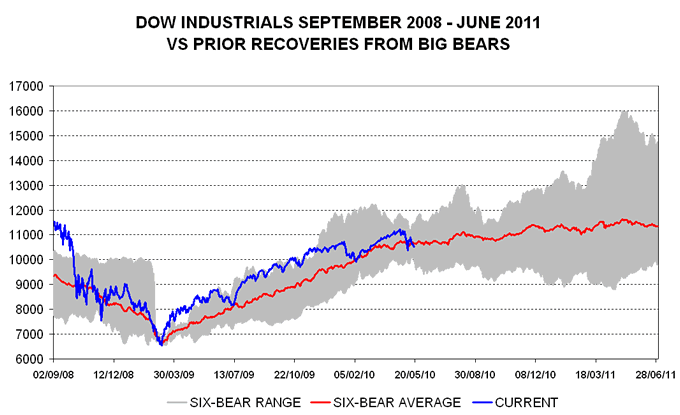US stocks converge with "six-bear average"
The Dow Jones industrial average fell by 54% between October 2007 and March 2009. There were seven declines in the Dow of 45% or more during the last century – see table. Six of the seven were in a range of 45-55%, the exception being the 89% fall between September 1929 and July 1932.
The chart compares the recovery in the Dow from its trough on 9 March 2009 with the rallies following these six prior bear markets, excluding the 1929-32 decline. The low of each bear was rebased and aligned with the March 2009 trough. The chart shows mean performance and the range across these prior falls and recoveries.
The Dow has been mostly ahead of the average since the March low, sometimes even straying above the range spanned by the prior rallies. This may reflect the unprecedented monetary stimulus unleashed by the Federal Reserve and other central banks amid the post-Lehman crisis. Also, the October 2007-March 2009 decline was slightly larger than the average (54% versus 48%), possibly contributing to a stronger recovery.
As the liquidity backdrop has deteriorated, however, the Dow has converged with the six-bear mean, closing marginally below it yesterday.
The average suggests that equity performance over the next year will be much less impressive than during the first 12 months of the rally. The level of the average at the end of June 2011 is 8% above yesterday's Dow close.
The chart, however, also shows that the range of performance during the second year of recoveries has been much wider than in the first. The "best-case" historical scenario would involve the Dow reaching 16,000 early next year. The minimum suggested level is 8,800 – still 34% above the 6,547 low reached last March.
Based on liquidity analysis, a fall into the lower half of the historical range seems more likely in the short term than renewed strength. With economic recovery expected to be sustained into 2011, however, a significant undershoot of the average could present another buying opportunity – especially if current turbulence forces central bank easing.
| Dow Industrials bear markets compared | ||||
| Duration | Magnitude | Change | Change | |
| first year | second year | |||
| months | % | % | % | |
| June 1901 - November 1903 | 29 | -46 | 59 | 22 |
| January 1906 - November 1907 | 22 | -49 | 65 | 13 |
| November 1909 - December 1914 | 61 | -47 | 85 | -3 |
| November 1919 - August 1921 | 22 | -47 | 56 | -8 |
| September 1929 - July 1932 | 34 | -89 | 156 | -8 |
| March 1937 - April 1942 | 62 | -52 | 44 | 2 |
| January 1973 - December 1974 | 23 | -45 | 42 | 17 |
| October 2007 - March 2009 | 17 | -54 | 64 | |


Reader Comments (2)
I just stopped in to check out this site....
Maybe the BEST topic that I have read all year?!